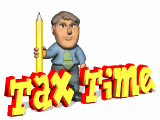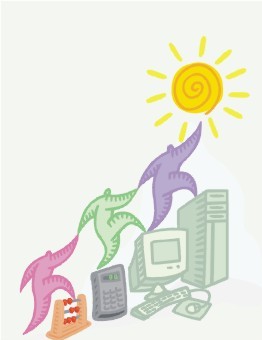 The eLedger
The eLedger
Volume I, Number 3, November 2008
IN THIS ISSUE of the The eLedger
We start off the November issue with a section called This and That. It is just what its title describes: an eclectic compilation of announcements, snippets and sometimes pithy stuff. Sometimes serious, sometimes funny.
Next we go to a book review of Thomas Friedman’s new book: Hot, Flat and Crowded: Why We Need a Green Revolution - and How It Can Renew America. In this era of renewed consciousness concerning the re-greening of our world, this book is must reading.
Lastly, our Pre-Tax Time Tidbits column addresses tax issues put into effect for 2008 to consider before the end of the year.
This and That
". . .therein lies the
central truth of globalization today: We’re all connected and nobody is in
charge."
Thomas Friedman, New York Times, October
19, 2008
Our country and the world at large are struggling to come to grips with bank
and business failures of major proportions that affect the welfare of every
human being on this planet. In this new era of socialism, government takeovers
and nationalization we are seeing things happen on a global scale that were
unheard of, whose warning signs were acknowledged by only a few. Nassim Toleb (The
Black Swan, The Impact of the Highly Improbable), warned of the probable
outcome of our profligate institutions but was ignored, as was Benoit
Mandelbrot. Socialism, nationalization? that kind of thing always happened some
place else, to someone else, not here and not to us. Not any more. We live in an
era where global economies which were built on a house of cards have been bled
dry by systemic greed, are failing almost every day, along with corporations we
never thought would fail.
were acknowledged by only a few. Nassim Toleb (The
Black Swan, The Impact of the Highly Improbable), warned of the probable
outcome of our profligate institutions but was ignored, as was Benoit
Mandelbrot. Socialism, nationalization? that kind of thing always happened some
place else, to someone else, not here and not to us. Not any more. We live in an
era where global economies which were built on a house of cards have been bled
dry by systemic greed, are failing almost every day, along with corporations we
never thought would fail.
In the NYT article referred to above, Tom Friedman shows clearly how a bank failure in a small relatively obscure country that we think of – when we think of it – as a vacation destination, was tied to globalization and the effects of the fallout from the global economic crisis.
One of the most unexpected and surprising bank failures recently took place in Iceland. Iceland? Seems the three banks that comprise most of the banking system in Iceland were paying very high interest on savings (5.45% vs. the 3.45% US banks pay out on some instruments) and borrowing a lot to pay for it and other spending. They ran their reserves down, and when the credit crunch hit they could not meet high depositor demand for withdrawals by borrowing it. In mid-October, Iceland nationalized these three banks. See the full article at: www.nytimes.com/2008/10/19/opinion/.
 TARP. We have a new acronym to add to our vocabulary: TARP (Troubled Asset Recovery Program). This is
the term for the part of the government’s $700 billion dollar bailout program
that is handing out $125 billion dollars for a capital injection into the
country’s largest banks to restore liquidity. It was hoped these institutions
would use these funds to make business and housing loans, although that was not
required. However, many of these banks are holding onto these funds to shore up
their reserves. There is even talk of the banks using the proceeds to finance
mergers! Unintended consequences?
TARP. We have a new acronym to add to our vocabulary: TARP (Troubled Asset Recovery Program). This is
the term for the part of the government’s $700 billion dollar bailout program
that is handing out $125 billion dollars for a capital injection into the
country’s largest banks to restore liquidity. It was hoped these institutions
would use these funds to make business and housing loans, although that was not
required. However, many of these banks are holding onto these funds to shore up
their reserves. There is even talk of the banks using the proceeds to finance
mergers! Unintended consequences?
In a report released by the Treasury Department at the end of October the recipients listed and payments made thus far (in billions) are: Citigroup, JP Morgan Chase, and Wells Fargo, $25 each; Bank of America, $15; Merrill Lynch, Morgan Stanley and Goldman Sachs $10 each; Bank of New York Mellon, $3; State Street of Boston, $2. The banks weren't give the option of refusing the funds.
The BOA’s CEO, Ken Lewis, said in an interview with 60 Minutes (October 20, 2008) that the bank was healthy and they don’t need the money. It doesn’t seem too much of a stretch to assume that the same is true for the majority of the remaining banks which received the handout, but they’re keeping mum!

What’s in a name? We’ve added something to our newsletter’s name. While we thought The Ledger was an aptly descriptive title for our newsletter, we felt it a tad reactionary (think green eye shades, and sleeve guards). We decided to affix an ‘e’ onto it so that it was more in keeping with our philosophy and with the age we live in. It is now The eLedger. This gives us a foothold in both the old and the new; just where we want to be.
Everything old is new again: "It's not so much the return on my money that concerns me as much as the return of my money." Will Rogers in a quote that painfully echoes our current economic situation. A person ahead of his time!
Book Review
Hot, Flat and Crowded: Why We Need a Green Revolution - and How It Can Renew
America
by Thomas Friedman

Hot ( global warming) + Flat (globalization) + Crowded (over-population) = Home (planet earth). In Thomas Friedman’s estimation these are the three prime issues of our time. He’s right.
I think I have read every book Thomas Friedman has written. So I am predisposed to automatically pick up any book he turns out. What surprised me about this one was the turnaround in his thinking between writing his last book, The World is Flat and this one, Hot, Flat and Crowded.
In The World is Flat Friedman is totally gung-ho on global markets and the global economy concept – he espouses the idea so readily and adamantly that I thought he over-stated his case. (He tends to do that in his books. It’s as though he gets so consumed by his topic that he gets compulsive about it.) In TWIF Friedman writes like a true free market advocate (and we all know where that has led us) with nary a thought of the dispossessed and the poor in third world countries, or elsewhere.
He’s the second author I’ve read in that past couple of years to take on the taboo of outing explosive population growth, in our own part of the world, third world countries and elsewhere. That topic is very unpopular and too hot to handle for many authors. Friedman does it with finesse. (Jerad Diamond was the other author who tackled this topic head-on in his book Collapse.)

What I really liked about HFC was that it wasn’t a gloom and doom diatribe and Friedman proffered solutions to what he calls the Energy-Climate Era perfect storm: "...the convergence of global warming, global flattening, and global crowding". His proposals to solving our global problems are somewhat idealistic and even naive at times, but that works for me. Any solution is better than none at all, which is pretty much where we are right now.
Tom Friedman writes in a style that flows well, is easy to grasp, easy to follow and easy to read. So if global warming, globalization and over-population matter to you, pick up a copy of this informative book, or download it to your ebook; it makes excellent reading.
 Pre-Tax Time Tidbits
Pre-Tax Time Tidbits
In just a few months it will be tax time. Again. In that spirit we thought we’d put in a few new things for you to consider before the end of the year and before it’s too late to act. Sections of the Economic Stimulus Act passed in February of this year will benefit both consumers and businesses on their 2008 returns.
Here are some of the ESA's provisions:
2008 tax rebate. Those individuals who did not qualify for the full 2007 rebate, will be able to try again when they file their 2008 tax returns next year. The maximum for qualifying individual taxpayers is $600, for married taxpayers filing jointly the maximum is $1,200.
Section 179 expense and bonus depreciation. For business the ESA included a temporary increase in the amount of assets purchased during 2008 that could be directly expensed under Section 179 (depreciation) and rescuitated bonus depreciation.
The Section 179 expense amount for qualifying property is now a maximum of $250,000 (on a maximum of $800,000 in purchases), twice as much as that of 2007 ($125,000 on a maximum of $500,000 in purchases). This is a temporary increase and unless extended next year will only apply to 2008. There is an additional $35,000 for qualifying Enterprise Zone property.
An additional 50% bonus depreciation on qualifying property has been reactivated. The bonus depreciation is calculated on any remaining basis after the Section 179 expense. Regular depreciation is then taken on the remaining basis of the asset.
To take advantage of the Section 179 expense deduction assets must be purchased by December 31, 2008. Bonus depreciation will be allowed for certain property placed in service in 2008 and 2009.
Address your comments and suggestions to Editor, The eLedger. We welcome your feedback. We want to know what you think, what topics you’d like to hear about.
